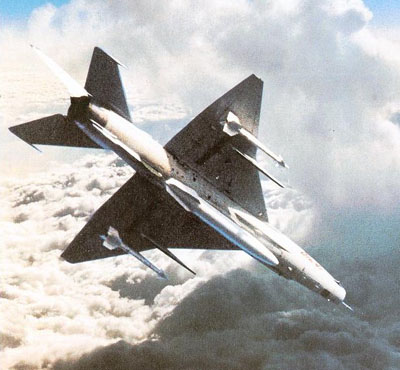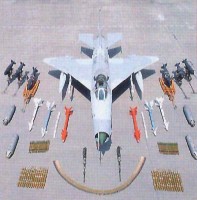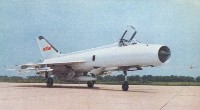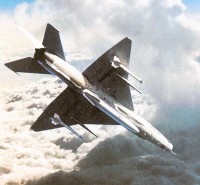Global Aircraft -- J-7 Fishbed
|
Aviation Center
US Attack
US Bombers
US Cargo
US Fighters
US Helicopters
US Patrol/Pursuit
US Reconnaissance
US Tankers
US Trainers
US UAV's
US X Planes
Orbiter Vehicles
WWI Aircraft
WWII Aircraft
Airbus
Antonov
Boeing
Dassault
Ilyushin
Kamov
MiG
Mil
Saab
Sukhoi
Tupolev
Yakovlev
Joint/Rest of World
Entertainment Center
Members Center
New Technologies
Contact Us
Extra Navigation
GAC Engine
J-7 Fishbed Specifications
J-7 Fishbed Features
The J-7 has a delta wing. The sweep angle on the leading edge is 57° with a TsAGI S-12 airfoil. The angle of incidence is 0° while the dihedral angle is -2°. On the trailing edge there are ailerons with an area of 1.18 m², and flaps with an area of 1.87 m². In front of the ailerons there are small wing fences.
A semi-monocoque with an elliptical profile with a maximum width of 1.24m. The air flow to the engine is regulated by a cone in the air intake. Up until the J-7 it is three staged. On speeds up to M=1,5 it is fully retracted, between speeds of M=1.5 and M=1.9 it is in the middle position, and with speeds higher than M=1.9 it is in the maximum forward position. However, on the J-7 it adapts to the actual speed, according to the UVD-2M system aboard the aircraft, which monitors the pressure in front and behind the compressor of the engine. On both side of the nose there are gills to supply the engine with more air while on the ground and during takeoff. In the first variant of the J-7, the pitot tube is on the bottom of the nose; after the J-7, every version of the J-7 has this tube situated on the top of the air intake. The cabin is pressurized and air conditioned. The canopy opens on a hinge on the front of the canopy. When ejecting, the SK-1 ejection seat connects with the canopy making a capsule to enclose the pilot and protect him from the airflow, after which it would separate and the pilot would parachute down. However, the canopy took too long to separate and some pilots were killed after ejecting at low altitudes. On the J-7 the canopy opens on a hinge on the right side of the cockpit. On the belly of the plane there are three air brakes, two at the front and one at the back. The front brakes have an area of 0.76 m², and a deflection angle of 35°. The back one has an area of 0.46 m² and a deflection angle of 40°. The usage of the back air brake is blocked if the plane carries an external fuel tank. Behind the air brakes are the bays for the main landing gear. Under the body, just behind the trailing edge of the wing, two JATO rockets can be attached. The front part of the fuselage ends with former #28. Beginning with former #28a is the back part of the fuselage, which is removable for engine maintenance. The empennage of the J-7 consists of a vertical stabilizer, a stabilator and a small fin on the bottom of the tail to improve yaw control. The vertical stabilizer has a sweep angle of 60° and an area of 5.32 m² (on earlier version 3.8 m²) and a rudder. The stabilator has sweep angle of 57°, an area of 3.94 m² and a span of 2.6m.
J-7 Fishbed Background
In the 1950s and early 1960s, the Soviet Union shared most of its conventional weapons technology with the People's Republic of China. One of these was the limited cooperation between the two countries in the early stage development of the famous MiG-21 short-range interceptor-fighter aircraft. Powered by a single engine and designed on a simple airframe, these fighters were inexpensive but fast, suiting the strategy of forming large groups of 'people's fighters' to overcome the technological advantages of Western aircraft. However, the Sino-Soviet split ended Chinese early participation in the developmental program of MiG-21 abruptly, and from July 28 to September 1, 1960, the Soviet Union withdrew its advisers from China, resulting in the project forced to stop in China.
However, Nikita Khrushchev suddenly wrote to Mao Zedong in February, 1962 to inform Mao that Soviet Union was ready to transfer the MiG-21 technology to China and asked Chinese to send their representatives to Soviet Union as soon as possible to discuss the details. Chinese viewed this as the Soviet gesture to make peace, and was obviously suspicious, but they were extremely quick to take upon the Soviet offer for the aircraft deal. A delegation headed by Colonel General Liu Yalou, the commander-in-chief of PLAAF and a Soviet military academy graduate was dispatched to Moscow immediately and the Chinese delegation was even allowed to have three days to visit the production facility of MiG-21, which was previously off limit to foreigners. The authorization was personally given by Nikita Khrushchev himself, and on March 30, 1962, the deal was signed. However, given the political situation and relationship between the two countries, Chinese were not optimistic on gaining the technology and thus were prepared for reverse engineering. Russian sources stated that complete examples of MiG-21 were sent to China flown by Soviet pilots, and did receive MiG-21Fs in kits along with parts and technical documents. Just as the Chinese had expected, as the Soviet delivered the kits, parts and documents to Shenyang Aircraft Factory five months after the deal was signed, Chinese discovered that the technical documents provided by Soviets were incomplete and some of parts could not be used. China set about to reverse engineer the aircraft for local production, and in doing so, succeeded in solving 249 major problems and came up with eight major technical documents that were not delivered. The effort was largely successful, as the Chinese design showed only minor differences from the original. In March, 1964, Shenyang Aircraft Factory begun the first domestic production of the jet fighter, which they successfully achieved next year. However, the mass production of the aircraft was severely hindered by an unexpected problem -- Cultural Revolution, which resulted in poor initial quality and slow progress, which in turn, resulted in full scale production only coming about in the 1980s, by which time the design was showing its age. However, the fighter is affordable and widely exported as the F-7, often with Western systems incorporated like the ones sold to Pakistan. Based on the expertise gained by this program, China later developed J-8 by utilizing the incomplete technical information of Soviet Ye-152 developmental jet gained. | ||||||||||||||||||||||||||||||||||||||||||||||




